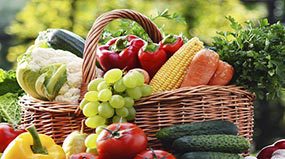The consumption of fruits and vegetables is of great importance for our health motivated to all the nutrients, vitamins, minerals, fibers that they contain. Fruits in the body have a regulatory function. The main component of fruits is water (80-90%), they contain significant amounts of carbohydrates (5-18%) and because of this composition, and they are sweet and energetic.
The carbohydrates they contain are mainly sugars that are easily digested and rapidly absorbed (fructose, glucose, and sucrose). In some ripe fruits, starch can also be found (for example in bananas), but as it ripens, it becomes simpler and more rapidly absorbed sugars. The contribution of proteins and lipids is low if we exclude avocado and coconut that have 16% and 60% lipids respectively.
Fruits are a good source of carotenes or precursors of vitamin A (especially those of intense colors such as peach, apricot, and plum), vitamin C (citrus fruits, strawberries, currants, pineapples, and kiwis), of various vitamins of the group B and vitamin E, among the minerals are potassium, magnesium, and calcium (although of low absorption). Pytochemicals (pigments that give the specific color to each fruit) with antioxidant properties that stop the deterioration of body tissues that accompanies aging are also present. Fruits provide fibers that concentrate primarily on the skin.
Vegetables form a very large group of foods, but all of them provide very similar nutrients. They are rich in vitamins, minerals and fibers so this group is considered together with fruits, as an example of regulatory foods. They have low energy content since almost 90% of its composition is water. They have low amounts of carbohydrates (around 8%) and these are mainly of the simple type (fructose, glucose, sucrose), its caloric value depends on the number of carbohydrates since the amount of lipids is unremarkable.
There is vitamin C in tomatoes, pigments and lettuce, provitamin A or carotenoids, in the most intense color such as carrot, they are the main source of folic acid, and especially those with green leaves such as spinach and chard, most contribute various minerals. They also have iron and calcium but not easily absorbed. It should be noted that they are rich in phytochemicals with antioxidant properties (vitamin C, provitamin A, zinc and selenium, flanovoids). These antioxidants are related to the prevention of cardiovascular diseases, degenerative diseases, and cell aging.
Fruits and vegetables are true healthy nutrient packages for all people. The antioxidant theory focuses on the role of micronutrients found in fruits and vegetables such as vitamins C and E, as well as phytochemicals. Carotenes (beta carotene, lutein, and lycopene), flanovoids (apples, onions, and beverages derived from plants such as tea, cocoa, and grapes) and phytoestrogens (mainly isoflavones) and lignans those are all beneficial to our health. Vegetables and fruits contain pigments of various colors that contribute to their natural attractiveness. Also, these natural coloring substances are beneficial to health.
How to maximize the nutritional value of fruits and vegetables?

The most successful way to make the most of all its properties is to consume them raw. Raw fruits and vegetables retain nutrients better since the heat used in cooking can decrease the content of some nutrients. Avoid prolonged cooking and overheating, introduce the vegetables in the cooking when the water is boiling, in case of peeling the vegetables and fruits, do it just before consuming them. Cook them preferably with husks and in large pieces. Steaming them better preserves the vitamin and mineral content.
It is recommended to consume 2-3 servings of fresh fruits a day and 2 servings a day of vegetables. On the other hand, it is important to highlight the benefits provided by the fibers contained in fruits and vegetables: they help cholesterol and blood glucose regulation, increases stool volume, regulates intestinal transit thus preventing colon cancer and increases the feeling of satiety.
In Costa Rica, for the year 2010, only two out of 10 people consumed fruits and vegetables, in 2018 this figure was up to four out of 10. This data revealed by the “Cardiovascular Risk Factors Survey” shows how the general population of the country is improving the behavioral indicators. The study is part of the actions carried out by the Costa Rican Social Security Fund (CCSS) to determine the behavior of the population with regards to protective and risk factors against the diseases that cause the most deaths in the population: cardiovascular diseases and cancer.
The CCSS sponsored survey was carried out throughout all the national territory. Doctor Roy Wong MacClure, an epidemiologist of the CCSS and coordinator of the aforementioned study, explained that, on this occasion, 73 variables were evaluated on 4,166 people 19 years or older were interviewed. The survey took into account behavioral and biological factors and was carried out with the support of the “Technical Assistants of Primary Health Care” (ATAPS). Among the important variables that were taken into account were: diet, smoking, physical activity, alcohol consumption, diabetes, high blood pressure, lipid profile such as cholesterol, overweight, and obesity.

